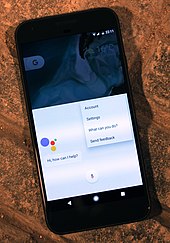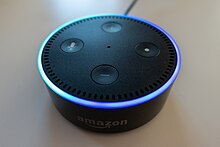Virtual assistant
In many cases, users can ask their virtual assistants questions, control home automation devices and media playback, and manage other basic tasks such as email, to-do lists, and calendars - all with verbal commands.[3] Into the 2020s, the emergence of artificial intelligence based chatbots, such as ChatGPT, has brought increased capability and interest to the field of virtual assistant products and services.It occupied a six-foot-high relay rack, consumed substantial power, had streams of cables and exhibited the myriad maintenance problems associated with complex vacuum-tube circuitry.[9] Another early tool which was enabled to perform digital speech recognition was the IBM Shoebox voice-activated calculator, presented to the general public during the 1962 Seattle World's Fair after its initial market launch in 1961.Weizenbaum was surprised by this, later writing: "I had not realized ... that extremely short exposures to a relatively simple computer program could induce powerful delusional thinking in quite normal people.The next milestone in the development of voice recognition technology was achieved in the 1970s at the Carnegie Mellon University in Pittsburgh, Pennsylvania with substantial support of the United States Department of Defense and its DARPA agency, funded five years of a Speech Understanding Research program, aiming to reach a minimum vocabulary of 1,000 words.While ChatGPT and other generalized chatbots based on the latest generative AI are capable of performing various tasks associated with virtual assistants, there are also more specialized forms of such technology that are designed to target more specific situations or needs.[40][41][42] This voice-activated device accesses user data to perform common tasks like checking weather or making calls, raising privacy concerns due to the lack of secondary authentication.Microwork has been criticized for the job insecurity it causes, and for the total lack of regulation: The average salary was 1,38 dollar/hour in 2010,[50] and it provides neither healthcare nor retirement benefits, sick pay, minimum wage.[49] Privacy concerns are raised by the fact that voice commands are available to the providers of virtual assistants in unencrypted form, and can thus be shared with third parties and be processed in an unauthorized or unexpected manner.[51] Additionally to the linguistic content of recorded speech, a user's manner of expression and voice characteristics can implicitly contain information about his or her biometric identity, personality traits, body shape, physical and mental health condition, sex, gender, moods and emotions, socioeconomic status and geographical origin.[59] According to an Ovum study, the "native digital assistant installed base" is projected to exceed the world's population by 2021, with 7.5 billion active voice AI–capable devices."[60] Taking into consideration the regional distribution of market leaders, North American companies (e.g. Nuance Communications, IBM, eGain) are expected to dominate the industry over the next years, due to the significant impact of BYOD (Bring Your Own Device) and enterprise mobility business models.Furthermore, the increasing demand for smartphone-assisted platforms are expected to further boost the North American intelligent virtual assistant (IVA) industry growth.Despite its smaller size in comparison to the North American market, the intelligent virtual assistant industry from the Asia-Pacific region, with its main players located in India and China is predicted to grow at an annual growth rate of 40% (above global average) over the 2016–2024 period.Virtual assistants are all the more important that their integration in small and middle-sized enterprises often consists in an easy first step through the more global adaptation and use of Internet of Things (IoT).[61] In May 2018, researchers from the University of California, Berkeley, published a paper that showed audio commands undetectable for the human ear could be directly embedded into music or spoken text, thereby manipulating virtual assistants into performing certain actions without the user taking note of it.



Virtual assistant (occupation)Personal digital assistantEmbodied agentGoogle AssistantPixel XLsmartphonesoftware agentchatbotAmazon AlexaSamsungartificial intelligencechatbotsChatGPTBell LabsIBM Shoebox1962 Seattle World's FairIBM Personal Computernatural language processingJoseph WeizenbaumELIZA effectCarnegie Mellon UniversityPittsburghUnited States Department of Defensehidden Markov modelphonemesWeak artificial intelligenceSpeech recognitionPhilipsLernout & HauspieIBM SimonNaturally SpeakingColloquisSmarterChildMSN MessengeriPhone 4SApple Inc.Siri Inc.spin-offSRI Internationalconversational interfacesHistory of artificial intelligenceGenerative pre-trained transformerNatural language generationLanguage modelgenerative AIAmazon Echo Dotsmart speakeronline chatinstant messagingSMS texte-mailConversicaAmazon EchoiPhoneAndroidGoogle LensSamsung Galaxyimage processingmachine learningambient intelligenceApple TVremote controlApple HomePodM (virtual assistant)FacebookFacebook Messengermobile operating systemBlackBerry 10CortanaMicrosoft WindowsSamsung Galaxy S8Note 8AeromexicoWeChatDomino's Pizzawearable technologyAlaska Airlinesinteractive voice responseAmerican AirlinesNuanceWikipediaSpotifyPandoraaudiobooksNetflixConversational commerceArtificial intelligence in governmentcall centree-commercelive chatWeb sitesWhatsAppCustomer supportVirtual assistant privacyvariety of privacy concernsman-machine communicationwords per minutefilter bubblesocial mediafake newsecho chambers.A. Casillimicro workingAntonio A. Casillisociologistneural networkslabelled data.microworksick payminimum wageAmazon Lexnatural language understandingActions on GoogleDialogflowWatsonavatarautomotiveretailNuance CommunicationsBring Your Own DeviceAsia-PacificInternet of Things (IoT)University of California, BerkeleyList of chatbotsFree softwareFree and open-source hardware